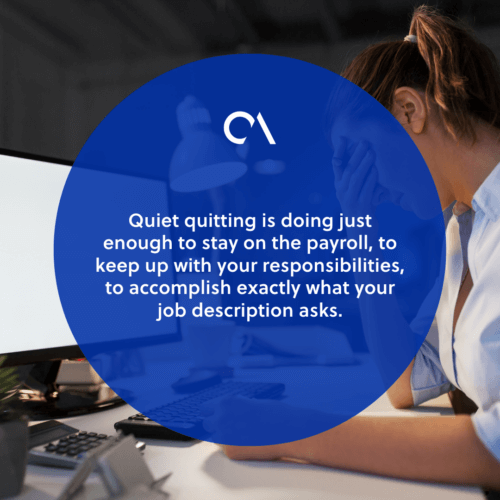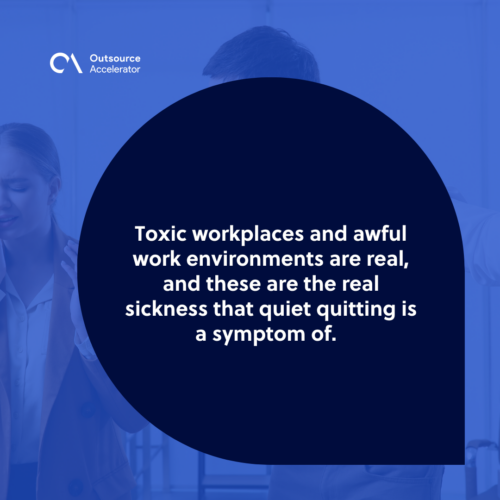Quiet quitting: Office menace or just employee sympathy?

Once again, another phenomenon has rattled the office (and online) community. This time it’s something called quiet quitting, and it’s affecting workplaces all over.
So what is the quiet quitting phenomenon? Is it really a cause for alarm, or something actually healthy?
What is quiet quitting?
No, it isn’t actually quitting your job. In fact, quiet quitting involves doing your job. But that’s it.
This includes logging in and out just in time, while doing just your required tasks in the hours in between.
Quiet quitting is doing just enough to stay on the payroll, to keep up with your responsibilities, to accomplish exactly what your job description asks. You don’t take your job too seriously, and you make sure work ends when the workday does.
Of course, there’s a deeper meaning to this. Quiet quitting is redefining the boundaries of work, and putting back focus on lives outside the office.

Elements of quiet quitting
So what does this look like in practice? Well there are a few characteristics to be observed in those who are quiet quitting:
- Learning the bare minimum effort to make at their work, then actually doing just that effort
- Not working outside their allocated work times
- Saying no to assigned tasks that are outside the agreed upon job description
- Not putting relentless productivity over health and wellbeing
- No more overachieving, with a reduced interest in going the extra mile to secure promotions
- Not announcing you’re quiet quitting (hence the quiet part)
- Not wanting to be defined solely by their job
- Placing more priority on life outside of work
- Mentally checking out of work
- Feeling exhausted
- Lack of engagement and emotional investment
The last three points in particular can be described with one word: burnout.[1] And it is in response to (or perhaps in anticipation of) burnout that the quiet quitting movement continues to gain traction.
Quiet quitting on the rise
The term itself began to go viral after 24-year old software engineer Zaid Khan used the words in a recent Tiktok video.
But for those who study workplace interactions, there is an argument that the feelings behind this movement have already been visible under different names throughout the decades: Disengagement, neglect, and withdrawal.
With the increased conversation on mental health today and the traces of the COVID-19 pandemic still present, it’s little wonder the quiet quitting trend is resonating so much.
Like many aspects of life in this decade, the pandemic can be pointed to for blame. During the time when we were all stuck in our houses, the lines between work and home blurred.
There was also a mortal fear gripping the world’s population, which led many to reflect on what was actually meaningful to them.
Gen Z embraces quiet quitting
It’s worth noting that a large part of the workforce now consists of those from the Gen Z age group, or those born in the mid-to-late 1990s.
Now, every generation enters the workforce and realizes it’s not as fun as they thought, but the difference is that this generation has the power of social media to air their thoughts and band together.
Gen Zs have not had an easy time growing up, despite constant claims their generation has been spoiled. Though more highly-educated, Gen Z has also had the least actual work experience, having gone through a global financial crisis, political turmoil, and a worldwide pandemic.
Adding to the trend of quiet quitting is that many young people have seen the effect “hustle culture” had on their elders – and they are not amused. Many can attest to having older family members that worked above and beyond but gained little to no personal or financial satisfaction.
Quiet quitting then can be seen as a means of this group to regain their agency, to take back their lives and live them as they see fit in ways that are meaningful to them.
No longer falling prey to “productivity traps” where the prize is a payoff that never comes, these young workers are now focusing on what’s important to them outside of work.
Naturally, this has had a mixed reception by their employers.

The impact of quiet quitting on work
Calling quiet quitting a “lazy Gen Z trend” misses the point, but that hasn’t stopped some more conservative managers from doing so.
Quiet quitting is hardly the call to panic that some employers make it out to be. After all, part of the description is literally doing your job.
It’s unexpected that many bosses will have difficulty understanding the concept. They are, after all, part of the reason behind it.
Toxic workplaces and awful work environments are real, and these are the real sickness that quiet quitting is a symptom of.
That’s not to say that quiet quitting is a completely positive idea. Forget the idea of promotion if you’re just checking off a list of tasks. It can also affect measurement of business process mapping, giving employers the wrong notion to hire more workers to increase efficiency.
Despite dominating the Tiktok airwaves, quiet quitting can hardly be called an actual movement. The act itself is more of an individual effort than a united front.
All employers would need to do then is to trim the fat by redefining their hiring qualities.
And even then, employers may design jobs that give workers control, fair wages, and pride in their work, but it will all be undermined by the rising cost of living crisis
If the economy goes south, quiet quitters would be the first to go. Workers would end up feeling short changed regardless.

Quiet quitting and the future of the workplace
On a smaller scale, there is still hope. This is still a solvable issue. At its heart, this all just comes down to effective communication.
It’s on managers to understand the origins of their teams’ burnout. Quiet quitting should be viewed less as a threat and more as an opportunity to re- engage their workforce.
The massive reaction to quiet quitting speaks to a broader issue, where employees are reassessing what their work means to them, and how much space it should occupy in their lives. Whether quiet quitting is the right move or not, the result is that people are beginning to see their worth.
Hopefully, this leads to more widespread solutions, such as defining appropriate workloads, or societal changes like better social security or the flexibility of a four-day work week.
At the end of the day, people are still doing what’s required of them. The output hasn’t changed, only the relationship to the job.
And that is not such a bad thing.







 Independent
Independent




